belt CITROEN DS5 2016 User Guide
[x] Cancel search | Manufacturer: CITROEN, Model Year: 2016, Model line: DS5, Model: CITROEN DS5 2016Pages: 403, PDF Size: 15.62 MB
Page 167 of 403
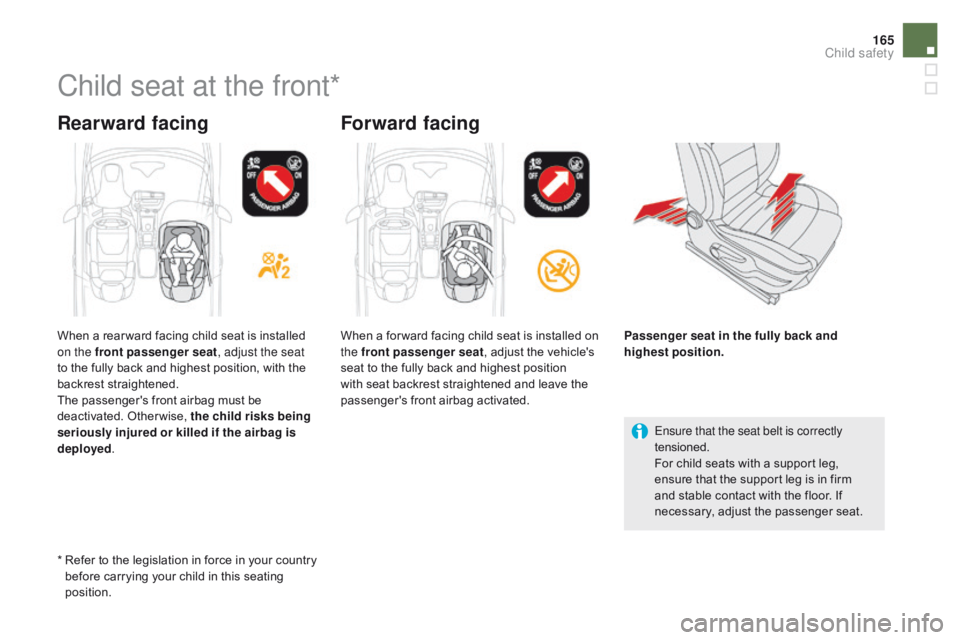
165
DS5_en_Chap06_securite-enfants_ed01-2015
Child seat at the front*
Rearward facingForward facing
Ensure that the seat belt is correctly
tensioned.
For child seats with a support leg,
ensure that the support leg is in firm
and stable contact with the floor. If
necessary, adjust the passenger seat.
Passenger seat in the fully back and
highest position.
When a rear ward facing child seat is installed
on the front passenger seat
, adjust the seat
to the fully back and highest position, with the
backrest straightened.
The passenger's front airbag must be
deactivated. Otherwise, the child risks being
seriously injured or killed if the airbag is
deployed . When a for ward facing child seat is installed on
the front passenger seat
, adjust the vehicle's
seat to the fully back and highest position
with seat backrest straightened and leave the
passenger's front airbag activated.
*
R
efer to the legislation in force in your country
before carrying your child in this seating
position.
child safety
Page 171 of 403
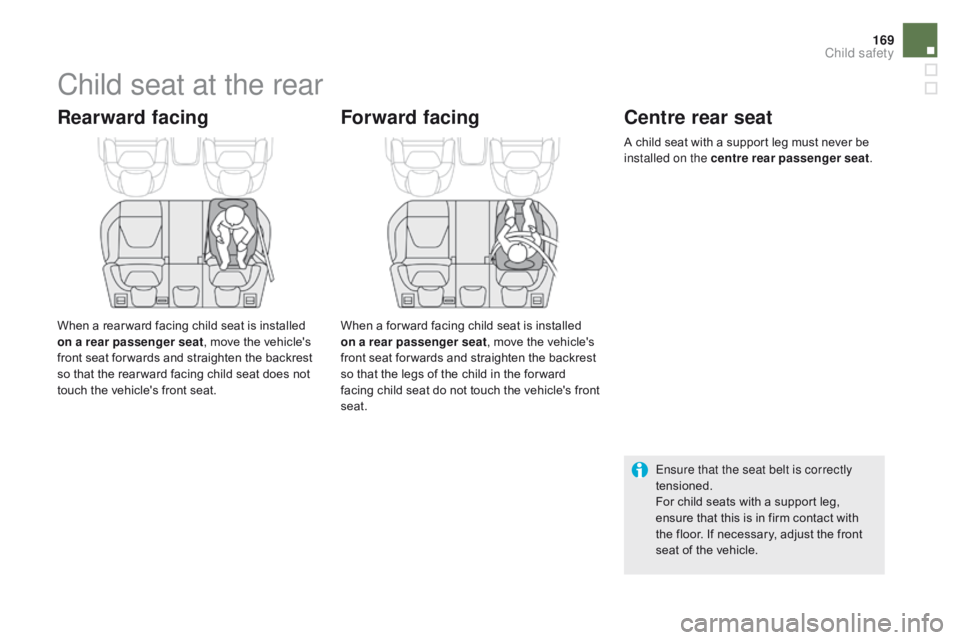
169
DS5_en_Chap06_securite-enfants_ed01-2015
Child seat at the rear
Rearward facing
When a rear ward facing child seat is installed
on a rear passenger seat, move the vehicle's
front seat for wards and straighten the backrest
so that the rear ward facing child seat does not
touch the vehicle's front seat.
Forward facing
When a for ward facing child seat is installed
on a rear passenger seat , move the vehicle's
front seat for wards and straighten the backrest
so that the legs of the child in the for ward
facing child seat do not touch the vehicle's front
seat.
centre rear seat
A child seat with a support leg must never be
installed on the centre rear passenger seat .
Ensure that the seat belt is correctly
tensioned.
For child seats with a support leg,
ensure that this is in firm contact with
the floor. If necessary, adjust the front
seat of the vehicle.
child safety
Page 172 of 403
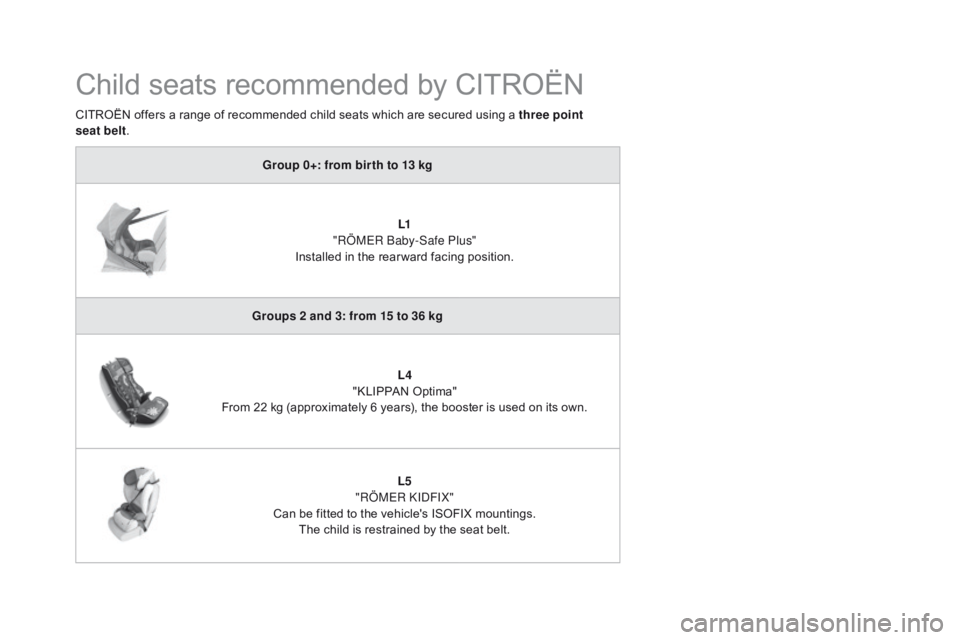
DS5_en_Chap06_securite-enfants_ed01-2015
Group 0+: from bir th to 13 kgL1
"RÖMER Baby-Safe Plus"
Installed in the rear ward facing position.
Groups 2 and 3: from 15 to 36 kg L4
"KLIPPAN Optima"
From 22 kg (approximately 6 years), the booster is used on its own.
L5
"RÖMER KIDFIX"
Can be fitted to the vehicle's ISOFIX mountings. The child is restrained by the seat belt.
Child seats recommended by CITROËN
CITROËN offers a range of recommended child seats which are secured using a three point
seat belt .
Page 173 of 403
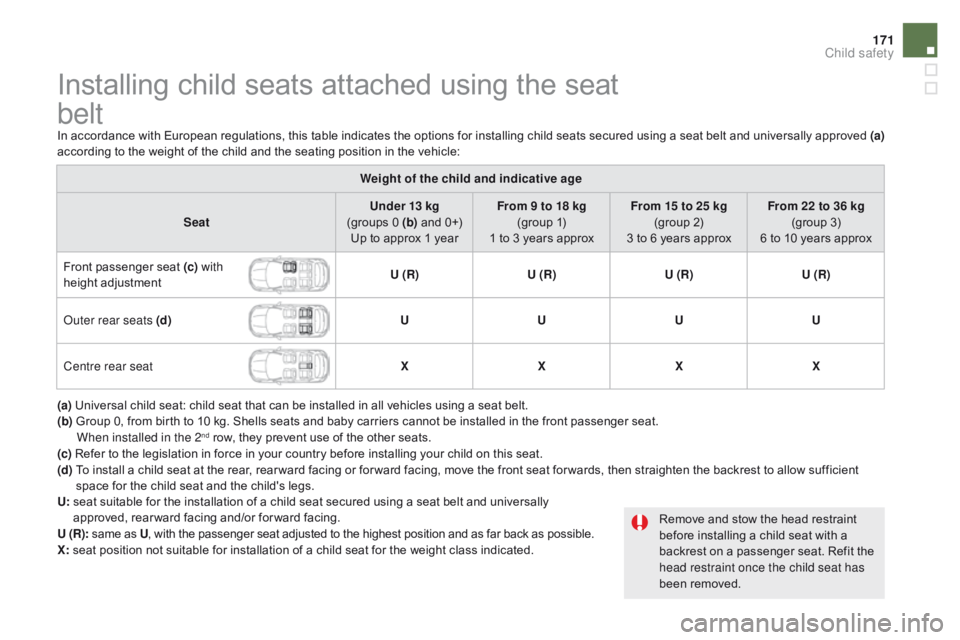
171
DS5_en_Chap06_securite-enfants_ed01-2015
Installing child seats attached using the seat
belt
In accordance with European regulations, this table indicates the options for installing child seats secured using a seat belt and universally approved (a)
according to the weight of the child and the seating position in the vehicle:
Weight of the child and indicative age
Seat Under 13 kg
(groups 0 (b) and 0+)
Up to approx 1 year From 9 to 18 kg
(group 1)
1 to 3 years approx From 15 to 25 kg
(group 2)
3 to 6 years approx From 22 to 36 kg
(group 3)
6 to 10 years approx
Front passenger seat (c) with
height adjustment U (R)
U (R)U (R)U (R)
Outer rear seats (d) UUUU
Centre rear seat XXXX
(a) Universal child seat: child seat that can be installed in all vehicles using a seat belt.
(b) Group 0, from birth to 10 kg. Shells seats and baby carriers cannot be installed in the front passenger seat.
W
hen installed in the 2
nd row, they prevent use of the other seats.
(c) Refer to the legislation in force in your country before installing your child on this seat.
(d)
T
o install a child seat at the rear, rear ward facing or for ward facing, move the front seat for wards, then straighten the backrest to allow sufficient
space for the child seat and the child's legs.
Remove and stow the head restraint
before installing a child seat with a
backrest on a passenger seat. Refit the
head restraint once the child seat has
been removed.
U:
s
eat suitable for the installation of a child seat secured using a seat belt and universally
approved, rear ward facing and/or for ward facing.
U (R):
s
ame as U , with the passenger seat adjusted to the highest position and as far back as possible.
X: seat position not suitable for installation of a child seat for the weight class indicated.
child safety
Page 175 of 403
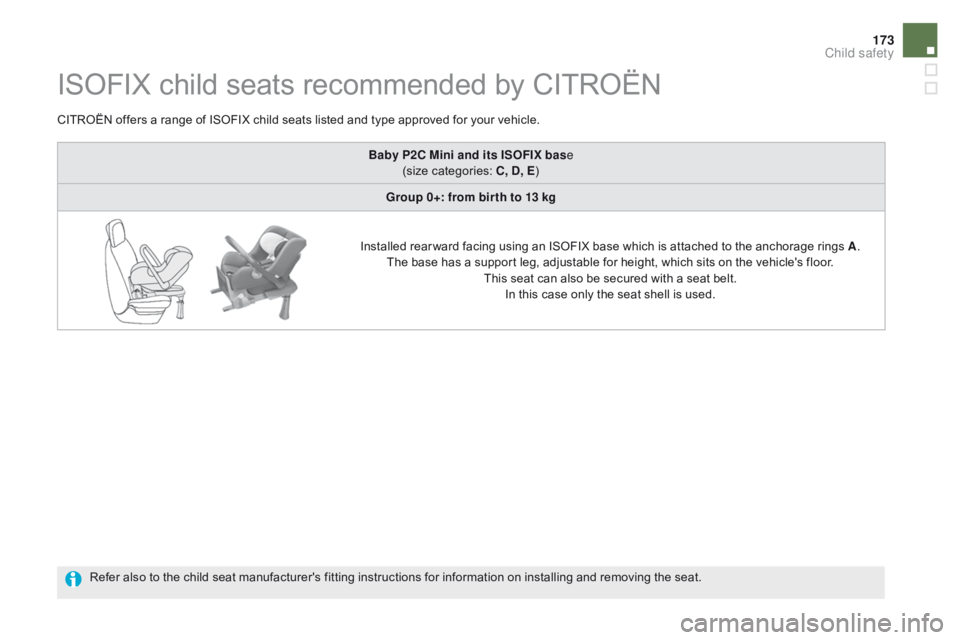
173
DS5_en_Chap06_securite-enfants_ed01-2015
ISOFIX child seats recommended by CITROËN
CITROËN offers a range of ISOFIX child seats listed and type approved for your vehicle.Refer also to the child seat manufacturer's fitting instructions for information on installing and removing the seat. Baby P2
c
Mini and its ISOFIX base
(size categories:
c,
d
, E)
G
roup 0+: from bir th to 13 kg
Installed rear ward facing using an ISOFIX base which is attached to the anchorage rings A .
The base has a support leg, adjustable for height, which sits on the vehicle's floor. This seat can also be secured with a seat belt. In this case only the seat shell is used.
child safety
Page 176 of 403
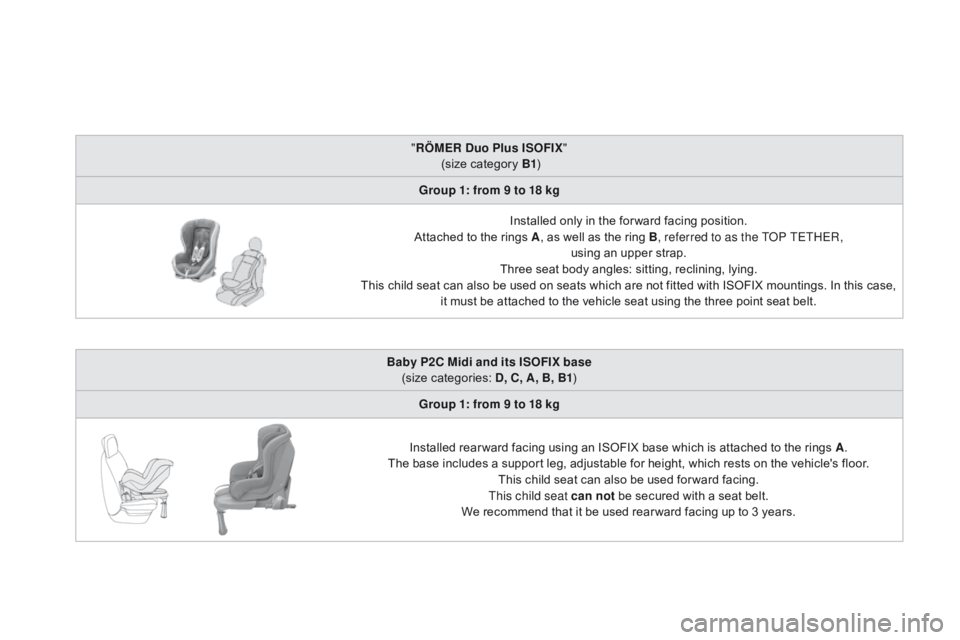
DS5_en_Chap06_securite-enfants_ed01-2015
"RÖMER du o Plus ISOFIX "
(size category B1 )
Group 1: from 9 to 18 kg
Installed only in the for ward facing position.
Attached to the rings A , as well as the ring B, referred to as the TOP TETHER,
using an upper strap.
Three seat body angles: sitting, reclining, lying.
This child seat can also be used on seats which are not fitted with ISOFIX mountings. In this case, it must be attached to the vehicle seat using the three point seat belt.
Baby P2
c
Midi and its ISOFIX base
(size categories:
d,
c
, A
, B, B1)
Group 1: from 9 to 18 kg
Installed rear ward facing using an ISOFIX base which is attached to the rings A .
The base includes a support leg, adjustable for height, which rests on the vehicle's floor. This child seat can also be used for ward facing.
This child seat can not be secured with a seat belt.
We recommend that it be used rear ward facing up to 3 years.
Page 179 of 403
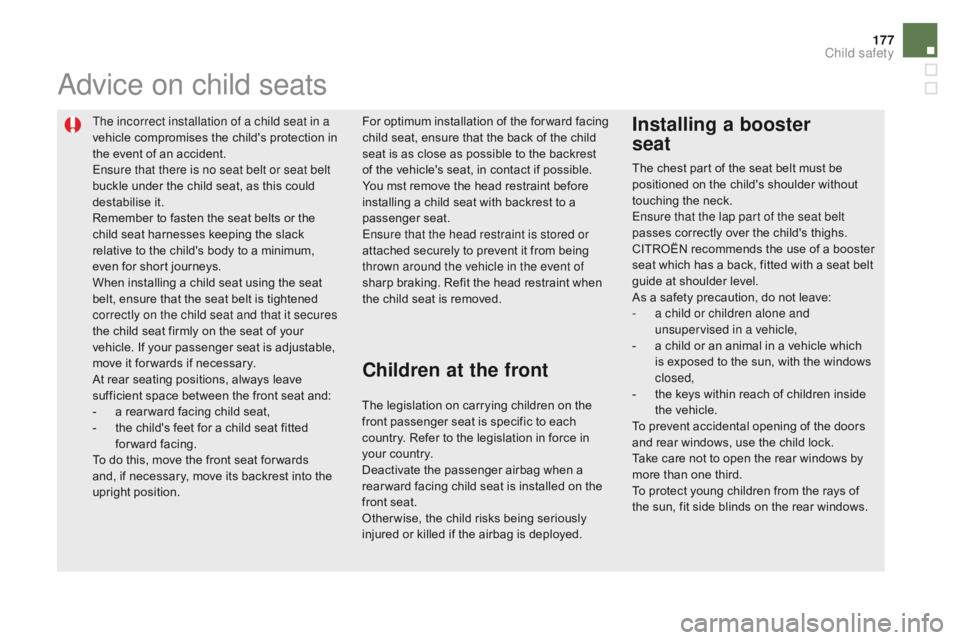
177
DS5_en_Chap06_securite-enfants_ed01-2015
The incorrect installation of a child seat in a
vehicle compromises the child's protection in
the event of an accident.
Ensure that there is no seat belt or seat belt
buckle under the child seat, as this could
destabilise it.
Remember to fasten the seat belts or the
child seat harnesses keeping the slack
relative to the child's body to a minimum,
even for short journeys.
When installing a child seat using the seat
belt, ensure that the seat belt is tightened
correctly on the child seat and that it secures
the child seat firmly on the seat of your
vehicle. If your passenger seat is adjustable,
move it for wards if necessary.
At rear seating positions, always leave
sufficient space between the front seat and:
-
a r
ear ward facing child seat,
-
t
he child's feet for a child seat fitted
forward facing.
To do this, move the front seat for wards
and, if necessary, move its backrest into the
upright position.
Advice on child seats
For optimum installation of the forward facing
child seat, ensure that the back of the child
seat is as close as possible to the backrest
of the vehicle's seat, in contact if possible.
You mst remove the head restraint before
installing a child seat with backrest to a
passenger seat.
Ensure that the head restraint is stored or
attached securely to prevent it from being
thrown around the vehicle in the event of
sharp braking. Refit the head restraint when
the child seat is removed.
children at the front Installing a booster
seat
The chest part of the seat belt must be
positioned on the child's shoulder without
touching the neck.
Ensure that the lap part of the seat belt
passes correctly over the child's thighs.
CITROËN recommends the use of a booster
seat which has a back, fitted with a seat belt
guide at shoulder level.
As a safety precaution, do not leave:
-
a c
hild or children alone and
unsupervised in a vehicle,
-
a c
hild or an animal in a vehicle which
is exposed to the sun, with the windows
closed,
-
t
he keys within reach of children inside
the vehicle.
To prevent accidental opening of the doors
and rear windows, use the child lock.
Take care not to open the rear windows by
more than one third.
To protect young children from the rays of
the sun, fit side blinds on the rear windows.
The legislation on carrying children on the
front passenger seat is specific to each
country. Refer to the legislation in force in
your country.
Deactivate the passenger airbag when a
rear ward facing child seat is installed on the
front seat.
Otherwise, the child risks being seriously
injured or killed if the airbag is deployed.
child safety
Page 190 of 403
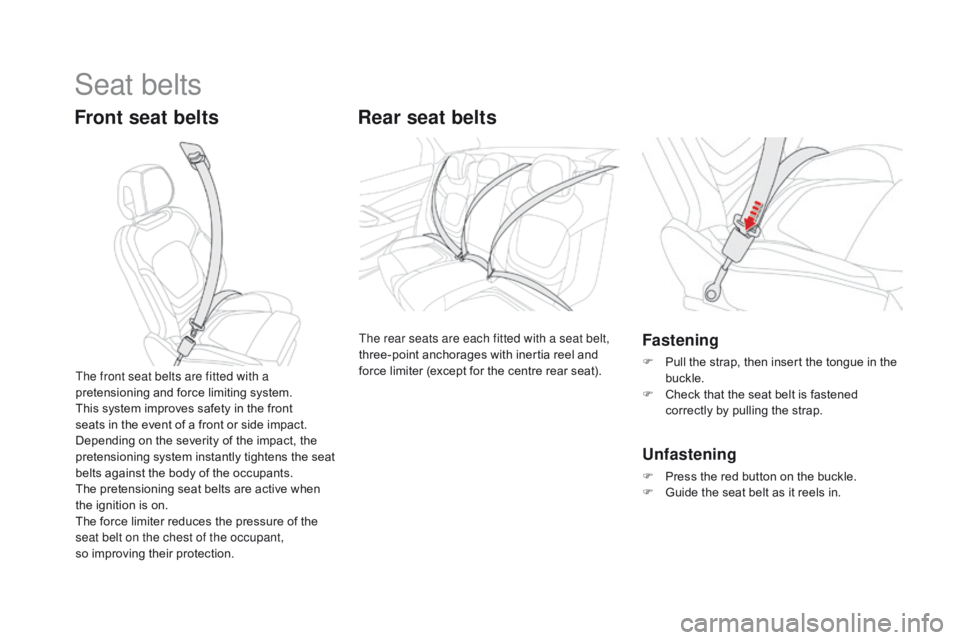
Seat belts
Front seat beltsRear seat belts
The rear seats are each fitted with a seat belt,
three-point anchorages with inertia reel and
force limiter (except for the centre rear seat).Fastening
F Pull the strap, then insert the tongue in the
buckle.
F
C
heck that the seat belt is fastened
correctly by pulling the strap.
Unfastening
F Press the red button on the buckle.
F G uide the seat belt as it reels in.
The front seat belts are fitted with a
pretensioning and force limiting system.
This system improves safety in the front
seats in the event of a front or side impact.
Depending on the severity of the impact, the
pretensioning system instantly tightens the seat
belts against the body of the occupants.
The pretensioning seat belts are active when
the ignition is on.
The force limiter reduces the pressure of the
seat belt on the chest of the occupant,
so improving their protection.
Page 191 of 403
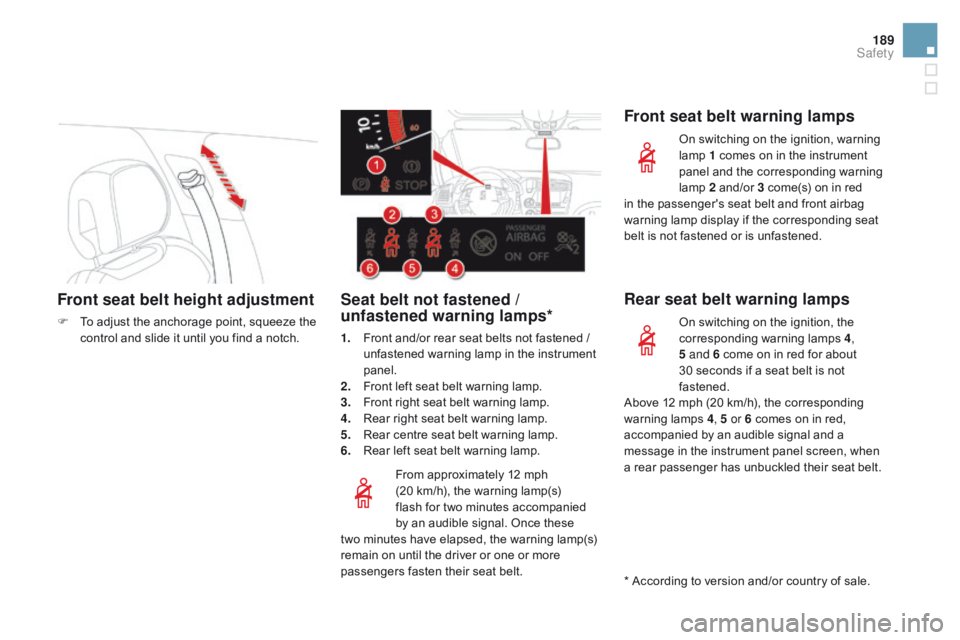
189
DS5_en_Chap07_securite_ed01-2015
Front seat belt height adjustment
F To adjust the anchorage point, squeeze the control and slide it until you find a notch.
From approximately 12 mph
(20
km/h), the warning lamp(s)
flash for two
minutes accompanied
by an audible signal. Once these
two
minutes have elapsed, the warning lamp(s)
remain on until the driver or one or more
passengers fasten their seat belt.
Seat belt not fastened /
unfastened warning lamps*
1. Front and/or rear seat belts not fastened / unfastened warning lamp in the instrument
panel.
2.
F
ront left seat belt warning lamp.
3.
F
ront right seat belt warning lamp.
4.
R
ear right seat belt warning lamp.
5.
R
ear centre seat belt warning lamp.
6.
R
ear left seat belt warning lamp.
Front seat belt warning lamps
On switching on the ignition, warning
lamp 1 comes on in the instrument
panel and the corresponding warning
lamp 2 and/or 3 come(s) on in red
in the passenger's seat belt and front airbag
warning lamp display if the corresponding seat
belt is not fastened or is unfastened.
Rear seat belt warning lamps
On switching on the ignition, the
corresponding warning lamps 4,
5 and 6 come on in red for about
30
seconds if a seat belt is not
fastened.
Above 12 mph (20 km/h), the corresponding
warning lamps 4, 5 or 6 comes on in red,
accompanied by an audible signal and a
message in the instrument panel screen, when
a rear passenger has unbuckled their seat belt.
* According to version and/or country of sale.
Safety
Page 192 of 403
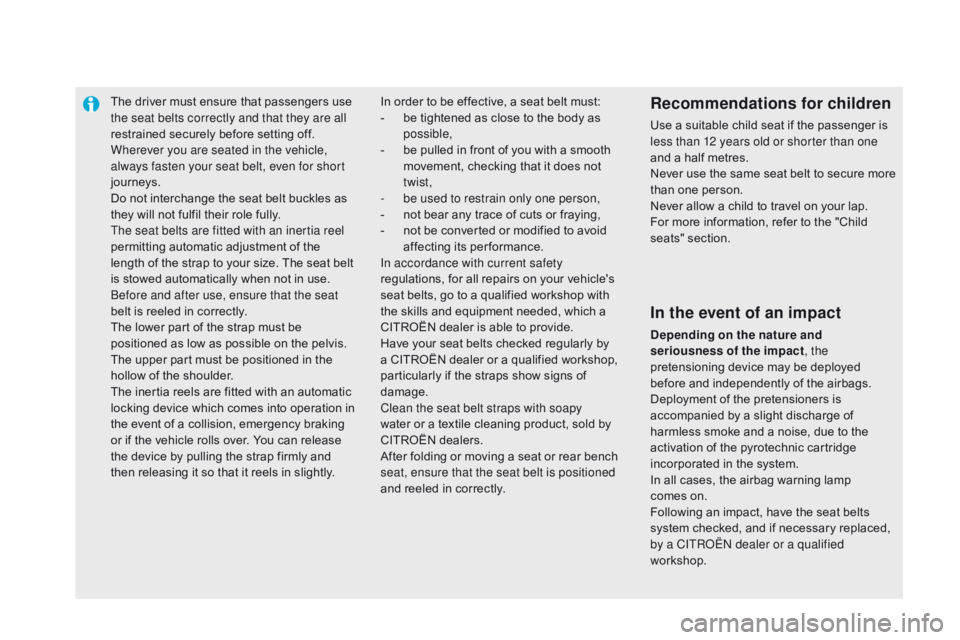
The driver must ensure that passengers use
the seat belts correctly and that they are all
restrained securely before setting off.
Wherever you are seated in the vehicle,
always fasten your seat belt, even for short
journeys.
Do not interchange the seat belt buckles as
they will not fulfil their role fully.
The seat belts are fitted with an inertia reel
permitting automatic adjustment of the
length of the strap to your size. The seat belt
is stowed automatically when not in use.
Before and after use, ensure that the seat
belt is reeled in correctly.
The lower part of the strap must be
positioned as low as possible on the pelvis.
The upper part must be positioned in the
hollow of the shoulder.
The inertia reels are fitted with an automatic
locking device which comes into operation in
the event of a collision, emergency braking
or if the vehicle rolls over. You can release
the device by pulling the strap firmly and
then releasing it so that it reels in slightly.Recommendations for children
Use a suitable child seat if the passenger is
less than 12 years old or shorter than one
and a half metres.
Never use the same seat belt to secure more
than one person.
Never allow a child to travel on your lap.
For more information, refer to the "Child
seats" section.
In order to be effective, a seat belt must:
-
b
e tightened as close to the body as
possible,
-
b
e pulled in front of you with a smooth
movement, checking that it does not
twist,
-
b
e used to restrain only one person,
-
n
ot bear any trace of cuts or fraying,
-
n
ot be converted or modified to avoid
affecting its performance.
In accordance with current safety
regulations, for all repairs on your vehicle's
seat belts, go to a qualified workshop with
the skills and equipment needed, which a
CITROËN dealer is able to provide.
Have your seat belts checked regularly by
a CITROËN dealer or a qualified workshop,
particularly if the straps show signs of
damage.
Clean the seat belt straps with soapy
water or a textile cleaning product, sold by
CITROËN dealers.
After folding or moving a seat or rear bench
seat, ensure that the seat belt is positioned
and reeled in correctly.
In the event of an impact
depending on the nature and
seriousness of the impact , the
pretensioning device may be deployed
before and independently of the airbags.
Deployment of the pretensioners is
accompanied by a slight discharge of
harmless smoke and a noise, due to the
activation of the pyrotechnic cartridge
incorporated in the system.
In all cases, the airbag warning lamp
comes on.
Following an impact, have the seat belts
system checked, and if necessary replaced,
by a CITROËN dealer or a qualified
workshop.